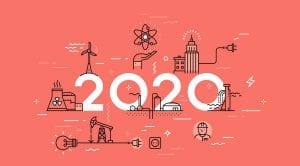Technology’s Role in Shaping 2020 – and Beyond – at Oil and Gas Firms
A version of this article was originally published in Power Magazine.
In the year 2020, the energy sector will continue to undergo major changes. From doubling-down on alternative energy sources – as the world places more importance on sustainability – to the large number of workers retiring in droves, there will be substantial shifts in the way energy companies, including oil and gas producers, prioritize in the new year and beyond.
Technology will be a driving force for those priorities as we look at 2020. While technology advancements don’t typically affect market-specific change – the energy market will always be unpredictable – technology can lessen the blow of more predictable issues, like the changing workforce and continuing challenges associated with on-the-job safety.
Energy companies will raise the priority of capturing human activity data to improve productivity, quality and safety, opening up new opportunities to apply machine learning
Energy companies will increasingly realize that human activity data is essential to gaining better insight into production processes. These insights will enable them to adjust, improve and streamline workflows, create new efficiencies, and create higher-quality product throughout the production chain.
Taking it a step further, combining “intelligent” machines and platforms with human activity data allows for another, deeper layer of insights, which can inform prescriptive next steps within a process, identifying patterns and even predicting future outcomes.
Here is a scenario of what that combination might look like in the real world. In an energy plant, if a valve breaks unexpectedly and an operator needs to shut down the process to fix the equipment, both human activity data and “intelligent” asset data will capture this event. Advanced machine learning then self-learns that pattern and the corresponding solution. It is then able to predict future malfunctions and the appropriate action to solve for them.
This level of advanced technology and prescriptive insight applied to an operator’s day-to-day work will make these jobs more efficient and, frankly, more attractive as a career choice to younger generations.
I say “attractive” because technology is a key component to drawing new talent into an industry, and attracting talent is vital for the industrial world as veteran workers continue to retire. Who is replacing these workers? It’s Millennials and Generation Z – two generations considered to be digital natives. This reality must translate to their jobs as well; in other words, their work lives must be just as enabled by technology as their personal lives.
(Read more: How Connected Work Enables Real Human-Machine Collaboration)
Safety really becomes a C-suite issue, as the correlation of safety to quality and overall operational efficiency becomes increasingly clear
There’s been a lot of focus of late on Amazon’s high worker injury rate – 9.6 serious injuries per 100 full-time workers, compared to the industry average of four per 100. Additionally, last year, the U.S. Bureau of Labor Statistics (BLS) reported more than 5,000 fatal workplace injuries in 2017 and more than 3.5 million injuries or illnesses on the job; many of those injuries took place in industrial environments, and most notably, that number is not much improved from a decade ago.
For energy companies, maintaining the status quo comes at a high price, both in terms of productivity, the bottom line, the reputation of their brand, and above all, the health of their workers. In 2020, expect the C-suite to turn its attention to elevating safety culture through technology, and adhering – fiercely – to regulations the industry sets to protect workers.
Connected worker technology can reduce industrial accidents by ensuring the best possible information is available to frontline and remote workers.
Safety checks are transformed from static, paper-based and often outdated protocols to digital, interactive processes. Safety “sub-routines” can be embedded directly into worker standard operating procedures (SOPs) instead of living as separate safety tasks that require special health, safety, and environment (HSE) management and oversight. SOPs can include reference documents, video tutorials, and/or audio instructions in different languages.
For example, an inspector out on the field could capture an equipment reading that indicates a dangerous situation is unfolding – but he or she may not have the expertise to diagnose and fix the problem on their own. Rather than waiting for additional instructions, or sending a team of experts onsite, a connected worker solution enables the inspector to quickly initiate a video conference call with one or multiple team members and receive immediate support and guidance.
(Read more: Don’t Plan for 2020 Without These Safety Stats)
Sustainability across the value chain will be a key driver in technology decisions; improving operational efficiency and limiting waste will be mandatory
The theme of the World Economic Forum’s 50th annual meeting in Davos this January is “Stakeholders for a Cohesive and Sustainable World,” a big indication that we need to stop paying lip-service to sustainability and actually make consequential commitments toward it, including technology. Organizations large and small will be held accountable to maintain sustainability from customers, investors, partners, and the general public, who increasingly see it as the mark of a trustworthy company.
In the energy sector specifically, technology is the future of sustainable energy efforts and will deliver value across the energy industry, dramatically limiting energy waste. A greener future is top of mind for most C-level executives, on a global scale. Ignoring calls for more sustainable processes will be a hindrance to any energy company that goes this route, and will negatively impact their business relationships as well as their public image.
Ultimately, 2020 is the year the energy industry will be ripe for technology innovation and change. Successful energy companies will be champions of these changes, redirecting business priorities to better align with 2020 goals.






